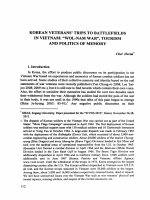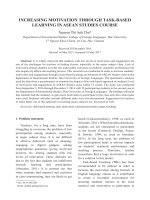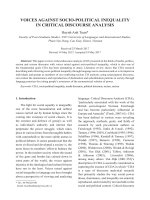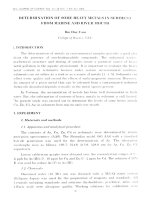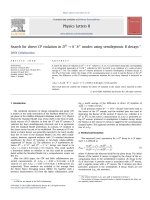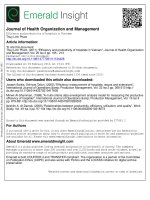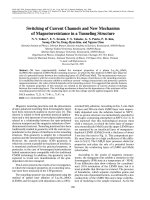DSpace at VNU: Increasing motivation through task-based learning in Asean studies course
Bạn đang xem bản rút gọn của tài liệu. Xem và tải ngay bản đầy đủ của tài liệu tại đây (1.73 MB, 15 trang )
INCREASING MOTIVATION THROUGH TASK-BASED
LEARNING IN ASEAN STUDIES COURSE
Nguyen Thi Anh Thu*
Department of International Studies, College of Foreign Languages, Hue University,
57 Nguyen Khoa Chiem, An Cuu, Hue, Vietnam
Received 30 December 2016
Revised 16 May 2017; Accepted 19 May 2017
Abstract: It is widely observed that students with low levels of motivation and engagement are
one of the challenges for teachers in leading classes, especially in the major subject class. Lack of
motivation among students not only has undesirable outcomes on students’ academic performance but
also negatively affects the teaching process. This research was conducted in order to increase students’
motivation and engagement through a task-based learning environment in ASEAN Studies class in the
department of International Studies, Hue University of Foreign Languages. The quantitative analysis
used the data from a questionnaire to examine the impact of the task-based approach on students’ level
of motivation and engagement in ASEAN Studies class within 15 weeks. The study was conducted
from September 3, 2016 through December 5, 2016 with 29 participating students in the second year at
the Department of International Studies, Hue University of Foreign Languages. The findings indicated
that students had the tendency to gain more motivation to participate in the class activities when tasks
were used. Students’ attitudes towards different tasks were also documented. Suggestions for teachers
to make better use of this approach in teaching major subjects are discussed as well.
Keywords: task-based learning, task, motivation, international studies major, teaching
1. Problem statement
Teachers, for a long time, have been
struggling to overcome the problem of low
participation among students, especially
in major subject class. It is not difficult
to observe behaviors such as sleeping,
engaging in digital gadgets, asking
inappropriate questions, giving irrelevant
answers, etc. among students with low
levels of motivation. These attitudes are
due to the fact that students are indifferent
towards
learning
and
participation
(Aboudan, 2011). It is pointed out that
when students find material and activities
in class uninteresting, they are likely to get
* Tel.: 84-913935281
Email:
bored (Csikszentmihalyi, 1990, as cited in
Aboudan, 2011). When boredom dominates,
students are not stimulated to participate
in the lesson (Caldwell, Darling, Payne,
& Dowdy, 1999, as cited in Aboudan,
2011). In the long term, the problem of
low participation leads to serious impacts
on students’ academic performance and
teaching process. Therefore, teacher
researchers find a huge motivation to seek
for a solution to this matter.
Task-based Learning (TBL) has been
recommended to be utilized in order to
increase the motivation among learners in
English language classes as it contributes
to create a favorable environment for
arousing students’ interest in the class
material and motivation to participate in
106
N.T.A. Thu / VNU Journal of Foreign Studies, Vol.33, No.3 (2017) 105-119
class activities (Ellis, 2003). In a task-based
learning, students are given a task to solve.
In this way, students can gain knowledge
on the major subjects easily without
concentrating on linguistic features during
task implementation (Willis, 1996).
Inspired by its positive effects on the
teaching and learning process, the teacher
researcher makes use of the Task-based
learning approach to promote motivation
in the ASEAN Studies class during 15
weeks. This research was carried out in
order to examine the impact of the taskbased learning approach on the level of
participation among students.
2. Theoretical framework
This section provides a review of the
literature on the fundamental concepts in
motivating students to learn major subjects:
motivation and task-based learning.
2.1. Motivation
In the research of Deci and Ryan (1985),
motivation is classified into two different
categories: intrinsic and extrinsic. While
extrinsic motivation is linked with external
factors such as rewards, intrinsic motivation
refers to the internal incentive to fulfill
learners’ satisfaction, (Deci & Ryan, 1985;
Lepper & Malone, 1987). This paper focuses
on ways to heighten intrinsic motivation
among learners in study major subject of
ASEAN Studies.
Seven factors are pointed out to promote
intrinsic motivation. In the first category of
individual factors which refer to students’
personal efforts, challenge, curiosity,
control and fantasy are deciding motives.
Gareau and Guo (2009) also agree that
these individual factors are essential factors
to engage students in class. Being engaged
in class instructions, learners tend to go
beyond the requirement of the instruction to
show their knowledge, skills, competence
and satisfaction (Gareau & Guo, 2009).
In the second category of interpersonal
factors, three interpersonal factors such as
competition, cooperation, and recognition
play a significant role in cooperative
learning when students are working with
others in a team (Lepper and Malone,
1987). This conclusion is reaffirmed in the
Self-Determination Theory developed by
Deci & Ryan (1985). Accordingly, learners’
behaviors are initiated to fulfill three
psychological needs, namely competence,
autonomy, and relatedness. This means that
students are motivated to participate when
they feel they can interact efficiently in the
environment, they can control the course of
activities, and they feel a sense of belonging
to the group.
In an effort to stimulate intrinsic
motivation, Ellis (2003) suggests that the
task-based learning is a new approach
which tremendously benefits learners in all
majors. Teachers who make use of tasks
hold a belief that as long as students find
motivations in their learning experience,
students can find a way to complete any
given tasks or achieve the desired goals
(Brophy, 2005).
2.2. Tasks-based Learning
In the last years, task-based learning
has been a vital instrument in language
teaching in promoting communication
and social interaction. In this model,
language is acquired by having learners
solve a problem or do a task without
much concentrating on linguistic aspects.
Language comes to learners along the
solving-problem process since the language
item used to complete tasks is similar as
it is in daily life beyond the class (Willis,
1996). Hence, it is argued that task-based
107
VNU Journal of Foreign Studies, Vol.33, No.3 (2017) 105-119
learning is an important approach for
students to connect their knowledge to
other tasks with communicative language
(Ellis, 2003).
Tasks play a significant role in this
learning and teaching model. Despite
several suggested definitions of a task, this
research adopts the definition by Willis
(1996). According to Willis (1996), a task is
“an activity where the target language is
used by the learner for a communicative
purpose (goal) in order to achieve an
outcome” (p. 23). Specifically, a task is a
class activity to use a target language to
achieve a goal (Ellis, 2003). This also means
the output of this learning experience is
both language acquisition and specialized
knowledge in the major subjects. This point
inspires the teacher researcher to apply the
model of Tasks-based learning in language
teaching into teaching major subject in
ASEAN Studies class.
Figure 1. The TBL Framework
(Source: Jane Willis, a Framework for Taskbased learning, Longman ELT)
According to Willis (1996), a task consists of
three stages: pre-task, task-cycle, and language
focus. In the pre-task stage, students are given
a topic and provided with necessary vocabulary
by the teacher. In the task cycle, students work in
pairs or in a small group to find the solution to a
common question before making a presentation
to the class. In the final stage, teacher will
examine and analyze the specific language that
students use in their report or their feedbacks
about others’ performance.
Pre-task
Teachers introduce the topic, provide useful vocabulary, and familiarize students with tasks instruction.
Learners read the texts to understand the tasks
TASK CYCLE
TASK
Students work in pairs or small
groups to implement the task.
Students might feel free to try all
methods they can think of.
Teacher supervises the students
from a distance, promote students
to communicate with one another
instead of correcting their language.
PLANNING
Students make a preparation to
present in front of class (orally or
writing) on the way they complete
the task, make a decision or achieve
in the end. As students give a report
in public, teachers will stand by their
side to provide any language support
if necessary.
REPORT
A few groups might spend
time to exchange their
findings or reports.
Teacher plays the role of
a chairperson to provide
feedbacks on students’
reports.
LANGUAGE FOCUS
LANGUAGE ANALYSIS
Students can have a reflection on the vocabulary they
used in their report. They can update some new words,
phrases they have learned in the field.
PRACTICE
Teachers analyze the language usage by
students in their report.
108
N.T.A. Thu / VNU Journal of Foreign Studies, Vol.33, No.3 (2017) 105-119
Another inspiring point is that any topic in
any fields can be elaborated into any kind of
tasks with the aim of promoting language
usage. This generation can be done by
adopting the typology for TBL framework
which lists six tasks and their possible learning
outcome (Willis, 1996:149).
provided by teacher and to determine the
learning outcomes which are finally achieved.
The research fundamentally offers a new
approach to effectively use tasks in teaching
a major subject in International Studies
major. The research attempted to answer two
questions:
No.
Task Types
Skills involved
Task’s outcomes
1
Listing
Brainstorming, fact-finding
Completed list or draft mind map
2
Ordering &
Sorting
Set out information sorted according to
specific criteria
3
Comparing
4
Problem
solving
5
Sharing
personal
experience
Sequencing, ranking,
categorizing, classifying
Matching, finding similarities &
differences
Analyzing real problem,
analyzing hypothesis situation,
reasoning, decision-making
Narrating, describing, exploring
and explaining attitude, reaction,
opinions
6
Creative tasks
A wide range of literature has been found
on the effect of task-based learning in the field
of teaching English as a foreign language
(ELT). Researchers have demonstrated
that TBL contribute to enhancing students’
motivation. Nevertheless, there is limited
knowledge on the application of this model
in teaching major subjects in International
Studies. Therefore, this research aimed to
utilize the task-based approach to engage
students in learning academic subjects like
ASEAN Studies.
3. Research objectives and questions
The objective of the study is to investigate
the impacts of tasks on motivating students
to engage more in ASEAN Studies class.
Specifically, the research investigates learners’
attitudes to the advantages or disadvantages
of particular tasks in Task- Based Learning
Identification of similarities & differences
Finding solutions to problems, which can be
then evaluated
Exchanging opinions & attitudes
End product - can be appreciated by wide
audience
1. To what extent do tasks motivate
non-English majors to engage and
participate in the class?
2. What are students’ attitudes
towards the use of particular tasks
in task-based learning in ASEAN
Studies Course?
4. Research methodology
4.1. Procedure
The tools utilized were a Questionnaire on
intrinsic motivation to investigate students’
perception of the impacts of tasks used in
ASEAN Studies Class. This tool was used
to document evidence of how tasks enhance
students’ motivation and engagement. Data
was collected during 15-week period from
September 5, 2016 through December 5,
2016. The questionnaire created on a Google
form was documented online. The final
VNU Journal of Foreign Studies, Vol.33, No.3 (2017) 105-119
results were saved on a Google spreadsheet.
There are ten questions with various choices
for responses in the questionnaire. In the first
part, students were provided with multiplechoice questions to explore whether the
utility of tasks motivate them to engage in
the class. In the second section on particular
tasks, students were requested to come up
with their own responses to explain their
preference on a certain tasks that they
had worked in ASEAN Studies class (see
Appendix A). A task-based lesson which was
generated based on Willis’ (1996) framework
for TBL on a topic of ASEAN Studies was
also developed (see Appendix B).
4.2. Participants
29 students in International Studies major
at the Department of International Studies,
Hue University of Foreign Languages
participated in this study. Their age range is
21. Most students had learned English as a
required subject for six years in high school
and in the first three years in university. The
class met once a week for ninety minutes.
109
Figure 2. Students’ responses to the question
“How likely are teachers to provide class
activities that are related to your interests?”
Figure 3 shows the respondents’ responses
to the question “How likely are you to engage
in classroom activities when tasks are used?”
According to Figure 3, 75.9% of students are
more engaged in the lesson with the utility of
different kinds of tasks. On the other hand,
24.1% students are demotivated to participate
in the class activities. It is a favorable
conclusion that no students asserted that tasks
make no difference in their engagement in
classroom activities.
5. Research findings and discussion
Figure 2 shows students’ responses to the
question, “How likely are teachers to provide
class activities that are related to your
interests?” According to Figure 2, 44.8% of
students believe that the tasks provided in
ASEAN class are very likely related to their
interests, 31% of students feel that the tasks
are most likely related to their interest, 24.1%
of the students feel the tasks are somewhat
likely related to their interest. It is a positive
sign that no students perceive the tasks are
not related to their interest.
Figure 3. Students’ responses to the question
“How likely are you to engage in classroom
activities when tasks are used?”
Figure 4 presents students’ evaluation
on the factors that make them interested in
tasks. 58.6% of students do not feel fears
when giving wrong answers in front of peers
or expressing unpopular answers. Likewise,
58.6% students feel confident because they can
show their abilities in front of class through
110
N.T.A. Thu / VNU Journal of Foreign Studies, Vol.33, No.3 (2017) 105-119
several tasks. 55.2% of students are excited
to join in a competition with other teams.
51.7% of students rated for the facts that
they are excited to join in a various learning
atmosphere. 48.3% students are motivated as
they collaborate and communicate with other
team members to achieve a common goal.
44.8% students consider the task as a challenge
and want to overcome it. 31% of respondents
claimed that the instruction is interesting and
worthy of attention. Only 20.7% of students
are encouraged that the tasks are do-able and
they can fulfill it.
Obviously, among the four factors in
intrinsic motivation mentioned in the
theoretical framework - attention, relevance,
confidence, and satisfaction, confidence is the
most recognized incentive that students
perceive in using tasks in ASEAN Studies
class. Besides the confidence factors,
satisfaction is also important motives for
students to engage themselves in class
activities. Attention comes next in their
importance to students. Few students consider
relevance much important to them in their
learning experience. However, interpersonal
factors are claimed to be more important than
three other individual factors, except
confidence factor. Particularly, recognition is
fundamentally leading factors among the
three, with competition and cooperation are
rated equally important in students’ perception.
Notes. The checkboxes for students are
provided in full as follows:
1. Students consider the task as
a challenge and feel excited to
overcome it
2. Students perceive the instruction is
interesting and worthy of attention
3. Student feel the tasks/questions are
do-able and they can fulfill it
4. Student feel excited about being in
the various learning atmosphere
5. Students are motivated to join in a
competition with other groups
6. Students communicate and collaborate
with other team members to work for a
common goal during activities
7. Student do not fear giving wrong
answers in front of peers or expressing
unpopular opinions
8. Learners feel confident because they can
show their capability in front of class
The data in Figure 5 demonstrates learners’
preference to the different tasks used in
ASEAN Studies class. Data indicates that
there are obvious differences among learners’
choices of their favorite tasks. Problem
solving (including solving a real problem and
decision-making) is ranked the highest with
44.8% choosing this task as their favorable
one while the results for other tasks were on
lower profile. Creative tasks and comparing
Figure 4. Students’ responses to the question “Check the reasons that make you NOT
bored with the ASEAN Studies class. Check all that apply.”
VNU Journal of Foreign Studies, Vol.33, No.3 (2017) 105-119
was both chosen by 41.4% of students while
listing, and sharing stories was voted by
37.9% and 31% respectively. Very few
students (10.3%) favored ordering tasks in the
class activities. To grasp a better understanding
of the impacts of each task on learners, the
questions from 5-10 were given in the
Questionnaire and reported in Figures 6, 7, 9,
12, 17 & 18.
111
learners so they do not feel bored. On the
other hand, more students prefer fact-finding
since it helps students improve skimming and
scanning in reading skills, and understand
the topic in a profound way; it is easy to find
the information in the articles without much
thinking; and it stimulates learner to read the
articles at home to have a better preparation.
Figure 5. Students’ reponse to the question “What task do you
enjoy using in ASEAN Studies class? Check all that apply.”
Notes. The checkboxes for students are
provided in full as follows:
1. Listing (mindmap, fact-finding)
2. Ordering (sequencing, classifying)
3. Comparing
(matching,
finding
similarities and differences)
4. Solving problem (solving a real
problem, decision-making)
5. Sharing
stories
(describing,
explaining reaction & attitudes)
6. Creative tasks (brainstorming, factfinding, comparing, problem solving)
Figure 6 outlines learners’ perception
on listing tasks. Specifically, among the two
tasks – mind-map and fact-finding, while
51.7% of respondents enjoyed finding facts in
the reading articles while 48.3% of students
prefer developing a mind-map. Learners also
stressed the importance of each tasks for them.
Mind-map was rated useful as it is visual,
lively, logical, and easy to understand the
topic; and it promotes critical thinking among
Figure 6. Students’ response to the question “In
terms of listing task, which task interests you?”
In terms of ordering tasks, only a
minority of students (20.7%) have a positive
attitude of sequencing task (see Figure 7).
These students claim that this task helps
students remember the timeline of events
which occurred in ASEAN history; thus
they can understand and remember well
ASEAN’s achievement and failure at a
particular period of time. A majority of
students (79.3%) of respondents emphasized
the importance of this classifying task as a
tool to deeply understand and well remember
the lesson by realizing the different facets
of ASEAN’s achievements, and promote
112
her/his critical thinking
decisiveness (Figure 8).
N.T.A. Thu / VNU Journal of Foreign Studies, Vol.33, No.3 (2017) 105-119
as
well
as
Figure 7. Students’ response to the question
“In terms of ordering task, which task
interests you?”
Figure 8. Students classifying the given
information on ASEAN’s achievement into
three categories – political, economic, and
socio-cultural achievements
The distribution of students’ attitudes
towards comparing tasks (including matching,
and finding similarities and differences) can
be found in Figure 9. It is presented that these
two tasks were favored by students, with
37.9% of students chose matching, and 62.1%
of respondents went for finding differences
and similarities. The former is reported to be
easier to fulfill than the latter because students
can guess the answers. Besides, matching task
enables them to realize the connection
between main ideas and supporting ideas (e.g.
events), so they can improve analysis skill
when they approach a problem. For some
students, matching makes learning atmosphere
more exciting and learners become more
active (Figures 10 & 11). With regards of
finding similarities and differences, one of the
students claimed that “In my opinion, I really
like finding similarities and differences more.
Because I have to read all carefully to find out
the similarities and differences so I can
remember a lot of information and knowledge”.
Besides, students like this task because it
helps them understand the nature of the
problem by comparing and contrasting two
issues; therefore, students find it easier to
remember the main knowledge of related to
the topic. Students are stimulated to explore
the topic more after completing this task. An
additional reason is that this task is quite
challenging to students, so they have to read
articles carefully to find the answer, so they
can remember the related knowledge.
Figure 9. Students’ response to the question
“In terms of comparing task, which task
interests you?”
Figures 10 & 11. Students working to match
the viewpoints on the Permanent Court of
Arbitrary (PCA)’s ruling on South China Sea
with correct ASEAN member states
VNU Journal of Foreign Studies, Vol.33, No.3 (2017) 105-119
113
The component of problem solving tasks
includes analyzing real or hypothetical situations,
reasoning and decision making. In this survey,
only analytical and decision-making tasks were
adopted. As shown in Figure 12, a vast majority
of students of 65.5% were fond of analyzing a
real problem task while 34.5% enjoyed decisionmaking. In the former task, students are likely to
utilize their critical thinking to pick up the details
of the problem, so they tend to understand the
issue deeper and remember the problem well.
Learners are also interested in analyzing the
problem as this task enables them to realize
related issues surrounding the focal topic which
they often ignore.
Figures 13, 14, 15 & 16. Students taking the
role of Representatives of ASEAN member
states at ASEAN Summit
Figure 12. “In terms of problem solving task,
which task interests you?”
Besides, students felt motivated in this task
as they are allowed to express their own ideas
about the problem. One student mentioned that
when she played the role of the Minister of an
ASEAN state to join in ASEAN Summit, she
had to put herself into the shoes of the leaders to
make a decision, in this way, she could show her
ability and knowledge in the field of economics,
education, or security (Figures 13, 14, 15 & 16).
Concerning
decision-making
task,
students claimed that they were motivated
to think quickly to seek for optimal answer,
so they became more decisive in their study.
Some students find this task useful because
it requires creativity from learners since they
have to think seriously about the problem
before making a decision on the possible
solution, so this is the best way for them to
have a closer look at the problem. For others,
decision-making task was preferable because
it provides them opportunities to express their
own knowledge about the problem and show
their abilities of problem-solving without a
fear of making mistakes (Figure 12).
114
N.T.A. Thu / VNU Journal of Foreign Studies, Vol.33, No.3 (2017) 105-119
In the TBL framework, sharing personal
experience task involves narrating, describing,
exploring & explaining attitudes and
expressing opinions and reactions. However,
the task of sharing personal experience was not
documented in this survey. This is a limitation in
applying Willis’s TBL framework into ASEAN
Studies class. This can be explained by the fact
that studying regional events in ASEAN is far
from personal experiences. Therefore, teachers
found it difficult to create a task to encourage
students to share their personal experiences
which should be related to the discussion topic
such as refugee crisis, ASEAN relations with
the superpowers, etc. in ASEAN class.
Figure 17 illustrates students’ attitude
towards personal experience sharing task in
ASEAN Studies class. 72.4% students prefer
explaining their attitude to describing their
experience which was chosen by 27.6%.
Those who were fond of the former believe
that this task allows them to understand their
feeling through the related activity, therefore,
understand more the discussed problem.
Besides, others felt excited to listen to their
peers’ sharing about their reflection about the
same activity they joined in, especially when
their reflections were creative and interesting.
In this way, the problem became clearer to
them and easier to understand. Apparently,
giving explanation about their attitude and
reaction in a class activity to understand a
topic is more interesting to students than
simply giving a description of their experience.
Figure 17. Students’ reponse to the question
“In terms of sharing personal experience
task, which task interests you?”
Figure 18 illustrates learner’s viewpoint on
different tasks used in a creative task. It can be
seen from students have a more favorable
attitude towards problem-solving (55.2%) and
brainstorming (44.8%) than comparing (31%)
and fact-finding (24.1%). A majority of students
agreed that being allowed to give their own
solution and decision to a problem made them
more creative, excited and engaging in the
class. A large number of students prefer
brainstorming tasks because it has no rules and
students can gain independence to come up
with their own answer in a comfortable learning
atmosphere. They also felt motivated as
brainstorming required them to think critically
about the problem and deepen their
understanding of the problem.
Figure 18. Students’ response to the question
“In terms of creative task, which task
interests you? Check all that apply.”
Figures 19 & 20. Students identifying state
territories in ASEAN and presenting their
culture to the class
115
VNU Journal of Foreign Studies, Vol.33, No.3 (2017) 105-119
6. Conclusion
The study provides students’ evaluation of
the TBL on students in learning a major subject
like ASEAN Studies. The finding highlights
that TBL is useful in increasing students’
motivation and engagement in ASEAN
Studies class. Among the factors that increase
students’ motivation which are mentioned in
the Literature Review, except the factor of
confidence, the three interpersonal elements
(recognition, competition and cooperation) are
more important than personal factors (fantasy,
challenge, curiosity, and control). This point is
important in a way that it encourages teachers
to organize group work to solve different tasks
in their class.
Among several skills that are suggested
by Willis (1996), students in ASEAN Studies
class are interested in particular skills which
are reflected as below. The result might be
useful to provide teachers with suggestions on
suitable tasks to fit students’ interest.
1. task of ordering – classifying –79.3%
(Figure 7),
2. task of sharing personal experience –
explain attitude and reaction – 72.4%
(Figure 17)
3. task of problem-solving – analyzing a
real situation – 65.5% (Figure 12),
4. task of comparing – finding the differences
and similarities – 62.1% (Figure 9),
5. creative task – problem-solving – 55.2%
(Figure 18),
6. task of listing - fact-finding – 51.7%
(Figure 6).
Bygate, M., Skehan, P., & Swain, M. (2001). Researching
pedagogic language learning, teaching and testing.
Harlow, England: Longman.de la Fuente, M. J.
(2006). Classroom L2 vocabulary acquisition:
Investigating the role of pedagogical tasks and formfocused instruction. Language Teaching Research,
Vol. 10, No. 3, pp. 263-295. Available from
10/12/2016 12:15
Deci, E. L., & Ryan, R. M. (1985). Intrinsic motivation
and self-determination in human behavior. New
York, NY: Plenum Press.
Ellis, R. Task-Based Learning and Teaching. (2003).
Oxford University Press.
Filer,
D.
(2010).
Everyone’s
answering:
Using
technology to increase classroom participation.
Nursing Education Perspectives, Vol. 31, No. 4, pp.
247-250. Available through
Gardner, R. C., & Lambert, W. E. (1972). Attitudes and
motivation in second language learning. Rowley,
MA: Newbury House.
Gareau, S., & Guo, R. (2009). “All work and no
play” reconsidered: The use of games to promote
motivation
and
engagement
in
instruction.
International Journal for the Scholarship of Teaching
and Learning, Vol. 3, No. 2, pp. 1-11. Available
through
edu:8080/xmlui/handle/10518/3638>,
Accessed
11/12/2016 15:30
Lepper, M. R., & Malone, T. W. (1987). Intrinsic
motivation
and
instructional
effectiveness
in
computer-based education. In R. E. Snow & M. J.
Farr (Eds.), Aptitude, learning and instruction, Vol.
3: Conative and affective process analyses (pp. 255267). Hillsdale, NJ: Lawrence Erlbaum
Nunan, D. (2004). Task-based language teaching.
Cambridge, England: Cambridge University Press
References
Aboudan, R. (2011). “Engage them, don’t enrage them
– student voices and what it takes to participate”.
English Language Teaching, Vol. 4, No.1, pp. 128134. Available through < />elt>, Accessed 10/12/2016 10:50
Brophy, J. (2005). Motivating students to learn (2nd
ed.). Mahwah, NJ: Lawrence Erlbaum.
Simpson, A. Task-Based Learning. Available through
< />
task-
based-learning.shtml>, Accessed 9/12/2016 9:15
Willis, J. (1996). A Framework for Task-Based Learning.
London: Longman. Pearson Education Limited
116
N.T.A. Thu / VNU Journal of Foreign Studies, Vol.33, No.3 (2017) 105-119
THÚC ĐẨY SỰ THAM GIA CỦA SINH VIÊN
TRONG GIẢNG DẠY MÔN NGHIÊN CỨU ASEAN
BẰNG PHƯƠNG PHÁP HỌC TẬP DỰA TRÊN NHIỆM VỤ
Nguyễn Thị Anh Thư
Khoa Quốc tế học, Trường Đại học Ngoại ngữ, Đại học Huế,
57 Nguyễn Khoa Chiêm, phường An Cựu, TP. Huế, Việt Nam
Tóm tắt: Một trong những khó khăn mà đa phần các giảng viên đều phải đối mặt trong việc
giảng dạy các môn chuyên ngành Quốc tế học là người học thường thụ động và lười tham gia
vào bài học. Điều này không chỉ tác động tiêu cực đến kết quả học tập của sinh viên mà còn ảnh
hưởng đến quá trình dạy học các môn chuyên ngành của giáo viên. Nghiên cứu này được thực
hiện nhằm xem xét tính hiệu quả của phương pháp học tập dựa trên nhiệm vụ trong việc thúc đẩy
động lực học tập bên trong cho sinh viên, từ đó họ sẽ tích cực tham gia vào bài giảng trong môn
ASEAN học tại Khoa Quốc tế học, Trường Đại học Ngoại ngữ, Đại học Huế. Dữ liệu được thu
thập từ bảng hỏi để đánh giá nhận thức của người học về tác động của phương pháp dạy học này
đến động lực học tập của họ. Nghiên cứu được tiến hành với 29 sinh viên năm thứ 4 tại Khoa
Quốc tế học, Trường Đại học Ngoại ngữ, Đại học Huế trong 15 tuần dạy học, từ 3/9/2016 đến
12/12/2016. Nghiên cứu chỉ ra rằng người học đã có thêm nhiều động lực để tham gia vào bài học
khi giáo viên đưa ra các nhiệm vụ để sinh viên giải quyết. Dựa trên kết quả thu được từ thái độ
của sinh viên đối với từng nhiệm vụ khác nhau trong các lớp học ASEAN học, bài nghiên cứu sẽ
cung cấp nhiều gợi ý cho các giáo viên để có thể phát huy hơn nữa phương pháp này nhằm thúc
đẩy động lực cho người học.
Từ khóa: phương pháp học tập dựa trên nhiệm vụ, nhiệm vụ, động lực, giảng dạy môn chuyên
ngành Quốc tế học
117
VNU Journal of Foreign Studies, Vol.33, No.3 (2017) 105-119
APPENDIX A: QUESTIONNAIRE
“Increasing Motivation in ASEAN Studies Class”
Please check your response to the following statements. Write any additional comments in the
notes section. This survey is anonymous. Please do not put your name on it.
1. How likely are teachers to provide class activities that are related to your interests?
☐Very likely
☐Most likely ☐Somewhat likely
☐Not likely
2. How likely are you to engage in classroom activities when tasks are used?
☐More likely ☐Less likely
☐Makes no difference
3. Check the reasons that make you NOT bored with the ASEAN Studies class. Check all
that apply.
☐ Students consider the task as a challenge and feel excited to overcome it
☐Students perceive the instruction is interesting and worthy of attention
☐Student feel the tasks/questions are do-able and they can fulfill it
☐Student feel excited about being in the various learning atmosphere
☐Students are motivated to join in a competition with other groups
☐Students communicate and collaborate with other team members to work for a common goal
during activities
☐Student do not fear giving wrong answers in front of peers or expressing unpopular opinions.
☐Learners feel confident because they can show their capability in front of class
4. What task do you enjoy using in ASEAN Studies class? Check all that apply.
☐listing (mind-map, fact-finding)
☐ordering (sequencing, classifying)
☐comparing (matching, finding similarities and differences)
☐solving problem (analyzing a real problem, decision-making)
☐sharing stories (describing, explaining reactions & attitudes)
☐creative task (brainstorm, fact-finding, comparing, problem solving)
5a. In terms of listing task, which task do you prefer? Check all that apply.
☐ mind-map ☐ fact-finding
5b. Why is this task is preferable to you?
……………………………………………………………………………………………………
……..………………………………………..……………………………………………………
6a. In terms of ordering task, which task do you prefer? Check all that apply.
☐ sequencing ☐ classifying
6b. Why is this task is preferable to you?
……………………………………………………………………………………………………
……..………………………………………………………………………………………………
…
118
N.T.A. Thu / VNU Journal of Foreign Studies, Vol.33, No.3 (2017) 105-119
7a. In terms of comparing task, which task do you prefer? Check all that apply.
☐ matching ☐ finding similarities and differences
7b. Why is this task is preferable to you?
………………………………………………………………………………………………………
…..…………………………………………………………………………………………………
8a. In terms of problem solving task, which task do you prefer? Check all that apply.
☐ analyzing a real problem ☐ decision-making
8b. Why is this task is preferable to you?
………………………………………………………………………………………………………
…..…………………………………………………………………………………………………
9a. In terms of sharing personal experience task, which task do you prefer? Check all that
apply.
☐ describing ☐ explaining reactions & attitudes
9b. Why is this task is preferable to you?
………………………………………………………………………………………………………
…..…………………………………………………………………………………………………
10a. In terms of creative task, which task do you prefer? Check all that apply.
☐ brainstorming
☐ fact-finding ☐ comparing ☐ problem solving
10b. Why is this task is preferable to you?
………………………………………………………………………………………………………
…..…………………………………………………………………………………………………
Thanks for your responses to this questionnaire!
APPENDIX B
A Task-Based Lesson in ASEAN Studies Course
Topic: Achievement of ASEAN
Level: 4-year university student
Time: 90 minutes
Objectives: By the end of the class, students can grasp a good understanding of ASEAN’s
achievement in all areas in the last 40 years since its establishment.
Preparation: cue cards of significant events in ASEAN
Stages
Pre-task
Aim
Procedure
Ss join the buffalo-farmer game.
T gives Ss questions to brainstorm the connection
between the game and relations in Southeast Asia
Ss are introduced to the region then.
context before ASEAN
Ss give individual reflective answer about
was established
Ss give individual reflective answer on the relation
(Activity 1)
between the buffalo and farmer; and make a
connection to the relations among regional states
then.
Interaction
Individual
VNU Journal of Foreign Studies, Vol.33, No.3 (2017) 105-119
Task
Cycle
Task 1
Planning
Report
Ss classify the given
events
Ss read the article before class and categorizing
the ASEAN significant events into corresponding
dimension of cooperation
Group
Ss match events
with corresponding
dimension.
Ss discuss and put each event into its correct
category of dimension of cooperation in ASEAN.
Group
Ss tell the answer to
the class
Task 2
Ss give a presentation
Planning
Ss find facts in the
reading articles to
support main idea
Ss present in front of
class
Report
Language
Focus
Ss analyze words
to describe events
(declaration, etc.)
Analysis1
Analysis 2 Ss analyze words
to describe area of
cooperation
Practice 1
119
Ss practice writing
skills
T may facilitate the discussion process.
Ss report to class. Other Ss listen and note the
differences from their own group’s answer.
T provides feedbacks.
Ss give a presentation on the significance of the
events on ASEAN cooperation.
Ss give a presentation on the significance of the
events on ASEAN cooperation.
Whole Class
Group
Group
Whole class
Ss give presentation on the significance of the
events to ASEAN and why the dimension of
cooperation is indicative of ASEAN’s achievement.
T provides feedbacks.
Ss choose key events and related words.
Group
T may give feedback.
Ss may develop synonyms to express the idea on
the contribution of ASEAN to the field.
T may give feedback.
Using the synonyms, Ss develop a topic sentence
on the contribution of ASEAN to a particular area
to replace the model sentence that T gave them in
the Activity 1.
Group
Group
